|

Old English Sheepdogs 2025 Wall Calendar

Just Old English Sheepdogs 2025 Wall Calendar

Old English Sheepdog 2025 Calendar

Old English Sheepdog Art Print
|
Old English Sheepdog Calendars
Old English Sheepdog calendars are a delightful choice for dog
enthusiasts who adore this energetic and friendly breed.
These calendars feature a collection of captivating
photographs or charming illustrations of the Old English
Sheepdog,
showcasing their unique characteristics and playful nature. illustrations of the Old English
Sheepdog,
showcasing their unique characteristics and playful nature.
The Old English Sheepdog, also known as the "Bobtail,"
is a large and shaggy dog breed originating from England.
With its iconic long and fluffy coat, this breed is known
for its distinctive appearance and gentle nature. Originally
bred for herding livestock, Old English Sheepdogs have
become beloved family pets known for their affectionate and
sociable personality.
Old English Sheepdogs are robust and muscular dogs with a
square-shaped build. They typically stand between 21 to 24
inches (53 to 61 centimeters) tall at the shoulder and weigh
around 60 to 100 pounds (27 to 45 kilograms). Their dense
double coat consists of a waterproof outer layer and a soft
undercoat, which comes in various shades of gray, often with
white markings.
One of the defining characteristics of the Old English
Sheepdog is its abundant coat, which covers the entire body,
including the face and eyes. Their long, shaggy fur requires
regular grooming to prevent matting and tangling. Many
owners choose to keep their Old English Sheepdogs in a
shorter "puppy cut" for easier maintenance.
While Old English Sheepdogs are not as active as some other
herding breeds, they still require regular exercise to keep
them physically and mentally stimulated. Daily walks,
playtime, and opportunities for off-leash activities in a
secure area are beneficial for their well-being. They have a
moderate energy level and can adapt to different living
environments, including apartments, as long as they receive
sufficient exercise and mental stimulation.
Old
English Sheepdogs are intelligent and eager to please,
making them trainable with consistent and positive
reinforcement methods. They have a strong herding instinct,
which can sometimes manifest as a tendency to try and "herd"
family members or other animals. Early socialization and
obedience training are essential to help them channel their
instincts appropriately.
In summary, the Old English Sheepdog is a lovable and
sociable breed known for its distinctive shaggy coat and
gentle nature. Their affectionate and adaptable personality
makes them well-suited as family pets. With proper grooming,
exercise, and socialization, Old English Sheepdogs can
thrive as devoted and cherished members of the household.
Did You Know?
Shaggy Coat and
Oversized Appearance: The Old English Sheepdog's long and
shaggy coat not only gives them a unique appearance but also
serves a practical purpose. The thick fur helps protect them
from various weather conditions and keeps them warm in cold
climates. Their large and bulky appearance is often
deceptive, as their coat gives them a fluffy and exaggerated
look.
Endearing "Bobtail" Name: The Old English
Sheepdog is often referred to as the "Bobtail" due to its
traditionally docked tail. Historically, their tails were
docked to signify their working status and to prevent injury
while herding. However, tail docking is now largely banned
in many countries, and undocked Old English Sheepdogs with
naturally long tails are also seen.
Natural Herding
Instinct: The Old English Sheepdog has a strong herding
instinct, despite being more commonly seen as a companion
breed today. This instinct can sometimes manifest in their
behavior, such as attempting to gather and corral people or
objects. While they may not actively herd livestock, their
herding heritage is still evident in their instincts and
occasional herding behaviors.
|








